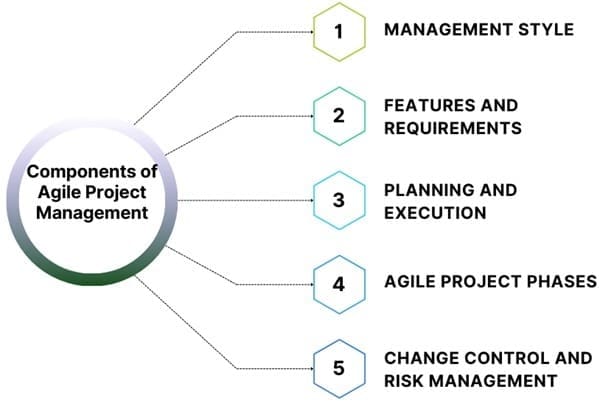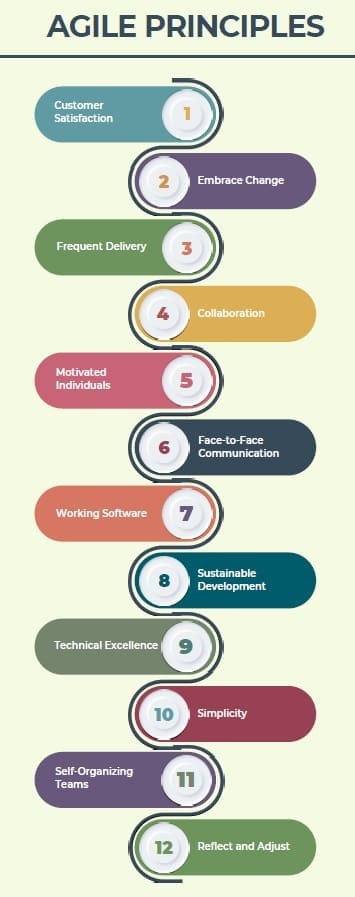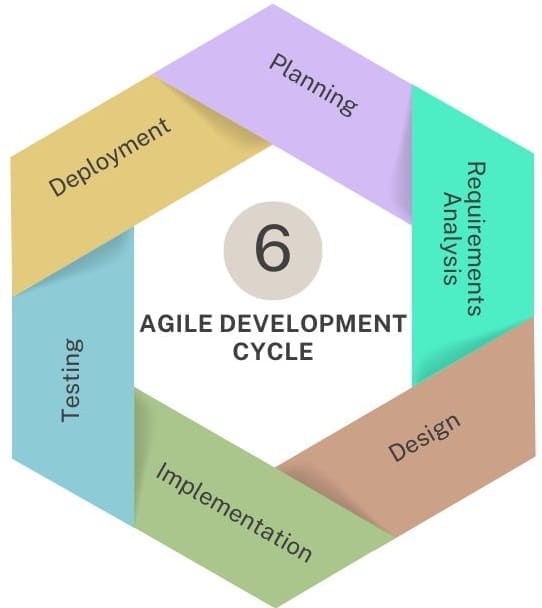In the early days of software development, project management followed a sequential design process known as the ‘waterfall’ model. This approach was well-suited for projects with well-defined, unchanging requirements. However, the nature of software development often involves changing requirements and evolving needs.
This led to the development more flexible and adaptive project management methodologies, collectively known as Agile.
Table of contents
- Agile Project Management
- Traditional Project Management: Waterfall Model
- Evolution of Agile
- Traditional vs. Agile Project Management
- The Agile Manifesto and Principles
- The Agile Development Cycle
- Advantages of Agile
- Disadvantages of Agile
- Agile Methodologies
- Implementing Agile in American Organizations
- Importance of Agile Project Management
- Final Read
- Related Articles
Agile Project Management
Agile project management is a dynamic and iterative approach that breaks down projects into smaller, manageable increments. It does not rely on extensive upfront planning, unlike traditional project management methodologies.
Instead, it allows for changing requirements and continuous feedback throughout the project lifecycle. This approach aims to deliver a working product at the end of each iteration, enhancing flexibility and responsiveness to customer needs.
Agile Project Management (APM) has revolutionized the way projects, especially in software development, are managed. Unlike traditional linear methodologies, Agile promotes flexibility, collaboration, and rapid delivery, adapting to changing requirements and ensuring customer satisfaction.
This essay delves into Agile’s best practices and methodologies, highlighting its principles, frameworks, and practical applications for an American audience.
Traditional Project Management: Waterfall Model
Traditional project management, often referred to as the Waterfall model, follows a sequential, step-by-step approach to project execution. This method involves distinct phases: initiation, planning, execution, monitoring, and closure. Each phase must be completed before moving on to the next, which makes this model suitable for projects with well-defined requirements and minimal changes.
Limitations of the Waterfall Model
The Waterfall model has been a dominant methodology since the early 1970s, primarily due to its structured nature and emphasis on planning and specifications development.
However, its rigidity and inability to adapt to changing requirements can lead to inefficiencies, increased costs, and potential project failures, particularly in dynamic fields like software development.
Evolution of Agile
Agile Project Management emerged as a response to the limitations of traditional methodologies. It emphasizes flexibility, collaboration, and customer satisfaction.
Agile’s history dates back to 1957 with early incremental development techniques used by pioneers like Bernie Dimsdale and John von Neumann. However, the modern Agile approach was officially introduced in 2001 with the Manifesto for Agile Software Development.
Core Principles of Agile

The Agile Manifesto outlines four core values:
- Individuals and interactions over processes and tools.
- Working software over comprehensive documentation.
- Customer collaboration over contract negotiation.
- Responding to change over following a plan.
These values are complemented by the Twelve Principles of Agile Software, which advocate for customer satisfaction through continuous delivery, welcoming changing requirements, frequent delivery of working software, and fostering collaboration between business stakeholders and developers.
Traditional vs. Agile Project Management
The Waterfall Model
Traditional project management, often referred to as the waterfall model, follows a linear and sequential approach. The phases of a project—requirements gathering, design, implementation, verification, and maintenance—are distinct and completed in order.
This model works well for projects with clear, unchanging requirements but is less effective when requirements evolve during the project lifecycle.
The Agile Approach
Agile project management, on the other hand, is iterative and incremental. It embraces change and promotes flexibility. Agile methodologies, such as Scrum, Extreme Programming (XP), and Lean Development, allow for continuous feedback and adaptation.
In Agile, the project is divided into small, manageable units called iterations or sprints, each delivering a potentially shippable product increment.
Difference Between Waterfall Model and Agile Model
| Basis | Waterfall Model | Agile Model |
| Approach | Sequential and linear | Iterative and incremental |
| Project Phases | Distinct phases: Requirements, Design, Implementation, Testing, Deployment, Maintenance | Iterative cycles called sprints or iterations |
| Flexibility | Rigid; changes are difficult to accommodate once requirements are defined | Highly flexible; changes can be accommodated at any stage |
| Planning | Comprehensive upfront planning | Continuous and adaptive planning |
| Requirement Changes | Changes are costly and difficult to implement | Changes are welcomed and incorporated regularly |
| Customer Involvement | Limited involvement; mainly at the beginning and end | Continuous involvement throughout the project |
| Feedback | Feedback is usually gathered at the end of the project | Frequent feedback through iterative reviews |
| Project Delivery | Deliverables are provided at the end of the project | Working increments are delivered at the end of each iteration |
| Documentation | Extensive documentation is prepared upfront | Minimal documentation; focus is on working software |
| Risk Management | Risks are managed upfront and throughout the phases | Risks are managed continuously throughout the project |
| Progress Measurement | Progress is measured by milestones and phase completions | Progress is measured by working increments and feedback |
| Team Collaboration | Team members work in silos; less collaboration | High level of collaboration and communication |
| Adaptability to Change | Low adaptability; scope and requirements are fixed early | High adaptability; scope can evolve based on feedback |
| Customer Feedback Integration | Integrated at the end of the project | Integrated continuously throughout the project |
| Suitability | Best for projects with well-defined requirements and minimal changes | Best for projects with evolving requirements and a need for flexibility |
Key Components

Management Style
In traditional project management, the project manager plays a directive role, often referred to as ‘command and control.’ In contrast, Agile project management adopts a facilitative approach. The project manager, often called a Scrum Master in Agile, ensures effective collaboration between the development team and the stakeholders, removing any impediments that may hinder progress.
Features and Requirements
Traditional project management fixes requirements at the beginning of the project, allowing time and resources to adjust as needed. Agile reverses this approach. Time and resources are fixed through a process known as time-boxing, while features and requirements are allowed to evolve at the start of each new iteration.
Planning and Execution
In traditional projects, the project manager develops and owns a comprehensive project plan. In Agile projects, planning is more flexible and adaptive. High-level planning is done at the beginning, but detailed planning is carried out by the development team at the start of each iteration, allowing for adjustments based on feedback and changing requirements.
Agile Project Phases
Agile projects are structured into several phases, each containing multiple iterations, leading to frequent product releases and implementations. This iterative approach ensures that the project can adapt to changes and deliver value incrementally.
Change Control and Risk Management
In traditional projects, change control is a formal process managed by the project manager. Agile projects use a features backlog, a prioritized list of requirements controlled by the stakeholders. Risk management in Agile is more dynamic, with developers owning development risks and stakeholders actively involved as product owners.
The Agile Manifesto and Principles

The foundation of Agile project management is built on the Agile Manifesto, which outlines four core values and twelve guiding principles. These principles emphasize customer satisfaction, adaptability, and collaborative work environments.
- Customer Satisfaction: Prioritizing customer needs through early and continuous delivery of valuable software.
- Embrace Change: Welcoming changing requirements, even late in development, to provide a competitive advantage.
- Frequent Delivery: Delivering working software frequently, from a couple of weeks to a couple of months, with a preference for shorter timescales.
- Collaboration: Ensuring business people and developers work together daily throughout the project.
- Motivated Individuals: Building projects around motivated individuals and providing the necessary environment and support.
- Face-to-Face Communication: Using face-to-face conversation as the most effective method of conveying information within the team.
- Working Software: Using working software as the primary measure of progress.
- Sustainable Development: Promoting sustainable development practices where sponsors, developers, and users can maintain a constant pace.
- Technical Excellence: Focusing on continuous attention to technical excellence and good design to enhance agility.
- Simplicity: Maximizing the amount of work not done, which is essential for efficiency.
- Self-Organizing Teams: Allowing the best architectures, requirements, and designs to emerge from self-organizing teams.
- Reflect and Adjust: Regularly reflect on how to become more effective and adjust behaviour accordingly.
The Agile Development Cycle

The Agile development cycle is characterized by its flexibility and iterative nature. The phases in this cycle include:
- Planning: Identifying features, prioritizing them, and assigning them to iterations.
- Requirements Analysis: Meeting with key stakeholders to identify business requirements that are quantifiable and detailed.
- Design: Preparing the design based on identified requirements and planning the testing strategy.
- Implementation: Coding or developing features and scheduling iterations for deployment.
- Testing: Testing the code against requirements through unit testing, integration testing, system testing, and acceptance testing.
- Deployment: Delivering the product to customers and addressing new issues in future iterations.
Advantages of Agile

Agile project management offers numerous benefits that make it a preferred choice for many project managers:
- Embraces Change: Agile methodologies allow for flexibility in planning cycles, enabling teams to refine and reprioritize the backlog to accommodate changes.
- Adaptable Goals: Suitable for projects where the end goal is not clearly defined, allowing goals to evolve as the project progresses.
- High-Quality Delivery: Breaking down the project into iterations ensures high-quality development, testing, and collaboration.
- Strong Team Interaction: Emphasizes frequent communication and face-to-face interactions.
- Customer Feedback: Provides numerous opportunities for customers to see the work, share input, and influence the end product.
- Continuous Improvement: Encourages feedback from users and team members to improve future iterations.
Disadvantages of Agile

While Agile methodologies offer significant advantages, they also come with certain challenges:
- Less Concrete Planning: Continuous reprioritization can lead to incomplete tasks and additional sprints, extending the overall timeline.
- Knowledgeable Teams: Requires team members to be highly skilled in various areas and well-versed in Agile principles.
- Time Commitment: Demands active involvement and collaboration, which can be more time-consuming than traditional approaches.
- Neglected Documentation: Prefers working deliverables over comprehensive documentation, which can lead to a lack of necessary records.
Agile Methodologies
Agile project management encompasses various methodologies, with Scrum and Kanban being two of the most popular.
Scrum
Scrum is a subset of Agile and is widely used for managing complex software and product development. It is based on iterative development cycles called sprints, which typically last one to two weeks. Key components of Scrum include:
- Product Backlog: A list of all desired features for the product.
- Sprint Planning: Determining the work to be completed during the sprint and moving it from the product backlog to the sprint backlog.
- Daily Scrum Meetings: 15-minute stand-up meetings where team members discuss their work, plans, and any roadblocks.
- Sprint Review: Presenting the completed work at the end of each sprint.
- Sprint Retrospective: Reflecting on the sprint to discuss improvements for the next iteration.
Kanban
Kanban, meaning “visual sign” or “card” in Japanese, is another Agile methodology that focuses on visualizing work, limiting work in progress, and maximizing efficiency. Inspired by the Toyota Production System, Kanban emphasizes just-in-time delivery and continuous improvement.
Components of a Kanban Board:
- Visual Workflow: Represents the workflow visually, typically with columns for to-do, in-progress, and done tasks.
- Kanban Cards: Each card represents a work item and is moved through the columns based on its status.
- Swim Lanes: Horizontal rows that categorize different types of work.
Hybrid
The Hybrid model combines elements of both Agile and Waterfall methodologies. It is suitable for projects with fixed deadlines and budgets but requires flexibility in certain phases. This approach leverages Agile’s adaptability while maintaining Waterfall’s structured planning.
Lean
Lean focuses on delivering value with minimal waste, promoting fast development cycles, and continuous improvement. It emphasizes efficiency and cost-effectiveness, making it suitable for projects requiring rapid delivery and iterative enhancements.
Key Principles of Lean:
- Eliminate Waste: Remove non-value-adding activities.
- Build Quality In: Ensure high-quality outcomes from the start.
- Deliver Fast: Shorten development cycles for quicker delivery.
When to Use Lean: Lean is best for projects where speed, efficiency, and continuous improvement are critical. It is widely used in industries like manufacturing and healthcare.
XP (Extreme Programming)
XP is an Agile framework that focuses on technical excellence and customer satisfaction through engineering practices. It emphasizes clear and simple code, frequent testing, and continuous integration.
Key Practices of XP:
- Pair Programming: Two developers work together on the same code.
- Test-Driven Development (TDD): Writing tests before coding to ensure functionality.
- Continuous Integration: Regularly integrating code changes to detect issues early.
When to Use XP: XP is ideal for projects requiring high-quality code and frequent customer feedback. It suits environments where technical excellence and rapid adaptation are paramount.
Implementing Agile in American Organizations
Adopting Agile methodologies in American organizations involves cultural and procedural shifts. It requires buy-in from all levels of the organization and a commitment to continuous improvement and collaboration.
Steps to Implement Agile
- Training and Education: Ensure all team members understand Agile principles and practices.
- Agile Coaches: Employ Agile coaches to guide teams and ensure adherence to practices.
- Tool Selection: Choose tools that support Agile methodologies, such as Jira for Scrum or Trello for Kanban.
- Pilot Projects: Start with a pilot project to demonstrate Agile’s benefits and refine processes.
- Feedback Loops: Establish regular feedback loops to assess and improve Agile practices.
Importance of Agile Project Management

Handling Changing Requirements
One of the most significant advantages of Agile is its ability to handle changing requirements. Customers often struggle to specify all their requirements upfront. Agile allows for iterative development, enabling customers to refine their requirements as they see the product evolve.
Increased Customer Involvement
Agile promotes close collaboration with customers. This continuous involvement ensures the product meets their needs and expectations, leading to higher customer satisfaction and better product alignment with business goals.
Faster Delivery of Results
Agile projects deliver working product increments at the end of each iteration. This not only provides early value to customers but also allows for quicker identification and correction of issues, leading to a higher quality product.
Enhanced Team Motivation
Agile empowers development teams by allowing them to organize themselves and make decisions collaboratively. This autonomy, combined with regular customer feedback, enhances team motivation and productivity.
Improved Product Quality
Agile methodologies emphasize technical excellence and good design. Continuous testing and customer feedback throughout the development process ensure high-quality products that meet customer needs.
Ideal Projects for Agile Methodology
Agile is particularly well-suited for projects with poorly defined or frequently changing requirements. It works best with small to medium-sized teams and projects with a relatively short timeline, typically less than a year. Projects that benefit from iterative product delivery and close customer collaboration are ideal candidates for Agile.
Final Read
Agile project management, with its emphasis on flexibility, customer satisfaction, and continuous improvement, offers a robust framework for managing complex projects. While it requires knowledgeable teams and a commitment to active collaboration, the benefits of Agile—such as adaptability, faster delivery, and strong team interaction—make it a valuable approach for many organizations.
Whether implemented through Scrum, Kanban, or other Agile methodologies, the principles of Agile project management provide a pathway to more responsive and efficient project execution.

About Six Sigma Development Solutions, Inc.
Six Sigma Development Solutions, Inc. offers onsite, public, and virtual Lean Six Sigma certification training. We are an Accredited Training Organization by the IASSC (International Association of Six Sigma Certification). We offer Lean Six Sigma Green Belt, Black Belt, and Yellow Belt, as well as LEAN certifications.
Book a Call and Let us know how we can help meet your training needs.



















